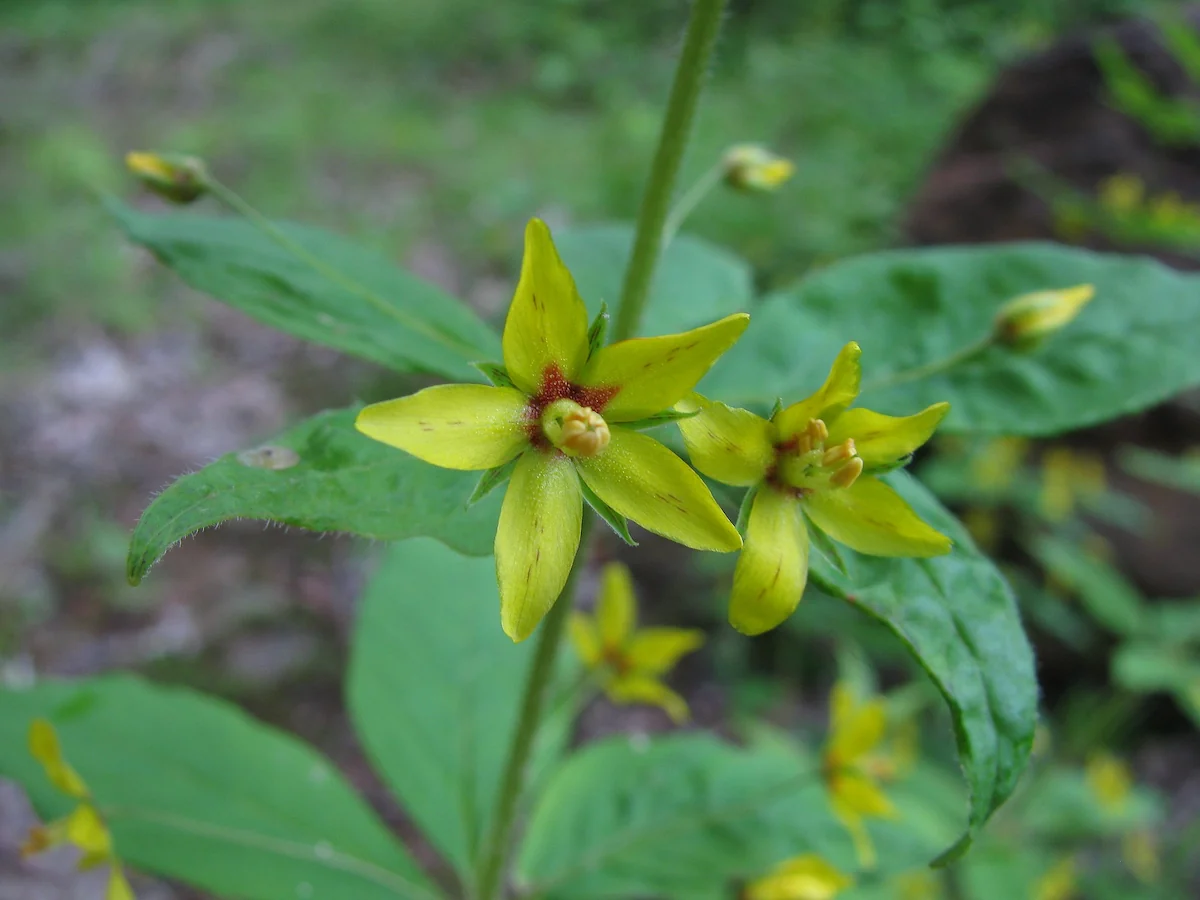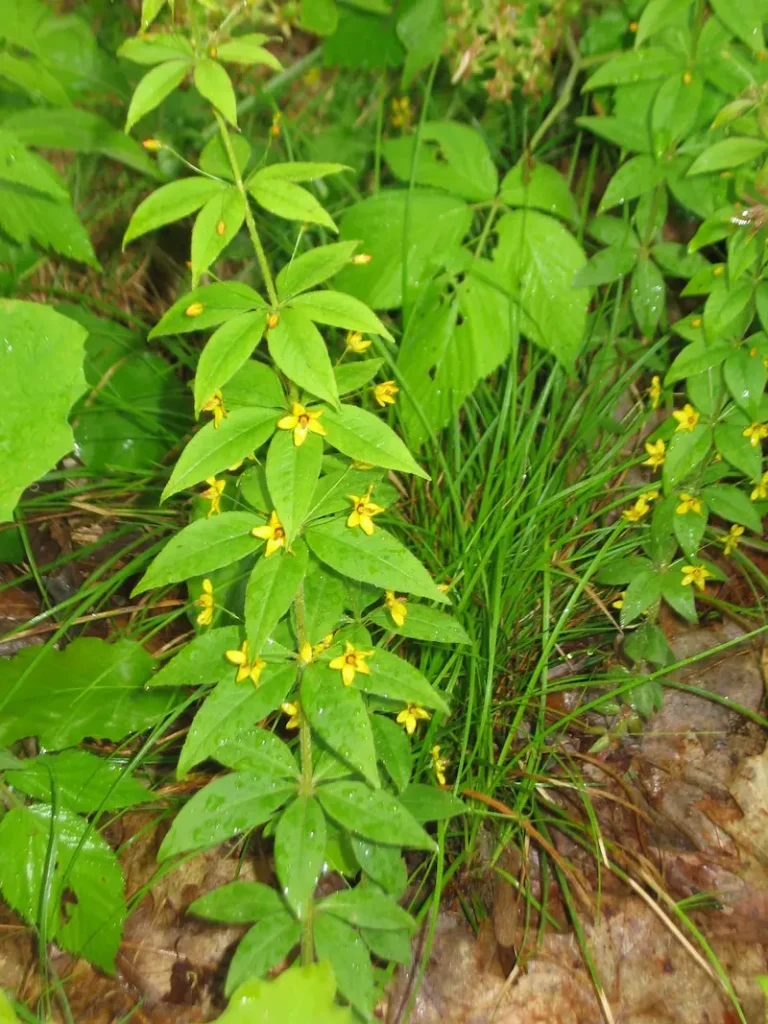Four-Flowered Yellow Loosestrife

Jomegat, CC BY-SA 3.0, via Wikimedia Commons
The four-flower yellow loosestrife, or Lysimachia quadrifolia, is a species of herbaceous plant in the Primulaceae family. It is indigenous to Canada and the eastern United States. An upright, branched form called Lysimachia quadriform grows to a maximum height of around 2 feet (0.61 m). It thrives on calcareous soils under moist to rainy circumstances.
The edges of the linear, robust leaves are primarily smooth. An inflorescence cluster gives rise to the flowers at the tips of the stems and branches. The five-parted, yellow flower blooms from July to August and has a reddish core. Wet meadows, grasslands, fields, swamps, and marshes are some of its habitats.
Quick Growing Guide
Botanical Name: Lysimachia quadriflora
Also Called: Prairie Loosestrife
En français: Lysimachia quadriflora
Colour:
Sun / Shade:
Water: Prefers moist soils
Height:
Pollinators:
The Appearance of the Four-flowered Yellow Loosestrife
Slender, upright or strongly rising, and hairless stems are characteristics. They could have a few branches above the center or appear to be unbranched. However, the lower nodes frequently have extremely short branches that look like a mass of leaves in the leaf axils. Shorter than stem leaves and on long leaf stalks, basal leaves are egg-shaped to elliptic and situated at the base of the plant. By the time the flowers bloom, they are usually gone.
The opposing stem leaves can occasionally look whorled due to the leaves in the leaf axils. They lack stalks entirely or almost entirely. The leaf blades are angled or tapered at the base and taper to a sharp point at the tip. The upper surface is smooth, hairless, and green to dark green in color. The lower part has no hair and has a light green color. There are no obvious subsidiary veins, and the midvein is prominent. There are no flecks or pits on the leaf surfaces (punctate). The margins are smooth, untoothed, curled-under, and possibly with a fringe of a few long hairs around the base.

Credit: Jomegat, CC BY-SA 3.0, via Wikimedia Commons
Compare this photo of the four-flowered yellow loosestrife to its sister plant, the yellow loosestrife.
Fruits and Flowering
The early stages of Four-flowered Yellow Loosestrife are unique: the shoot only expands to the size of a hand span after sending out a runner, which then takes root and develops into a full-sized plant. This wandering rootstock assists loosestrife in forming large stands. In addition to effective vegetative reproduction, yellow loosestrife often produces a profusion of flowers at the end of the summer. Although the flowers lack nectar, their copious amounts of pollen draw flies and bees as pollinators. Throughout the entire winter, the stalk persists, rattling the seeds inside their elongated capsules.
An inflorescence is known as a single bloom or whorl of flowers that rise from the middle and upper leaf axils. At the end of a lengthy, hairless stem, each bloom nods. The arrangement frequently forms a whorl of four blossoms, each of which nods and points in a different direction at the end of a thin stalk.
A single style, five petals, five stamens, and five sepals are present. The sepals are joined at the base to form a very short tube (calyx), which is subsequently divided into five long, widely spaced, narrowly lance-shaped lobes at the tip. They feature 3 to 5 parallel, frequently reddish-brown veins and are yellow with green undertones. They are not punctate, gland-dotted, or hairless. Yellow, widely spaced, roughly rounded petals range in size from 14 to 38 inches. They have a crimson foundation. At the tip, they quickly taper off to a point. Near the tip, the edges may be irregularly toothed and appear gnawed (erose), but the margins are often smooth. The stamens are not united into a tube; they are free. They have long, hairy filaments that are yellow or reddish.
The loosestrife fruit is a capsule with that is glossy, hairless, and widely egg-shaped. The calyx’s spreading lobes continue to exist when in fruit. Additionally, the design retains a long, pointed spine at the tip. The capsule ripens in the fall and can contain up to 20 or more seeds.
Habitats
Original habitats for yellow loosestrife include various types of fertile wetlands, where it frequently grows next to the water. Yellow flowers of the plant can also be seen in cities, on soggy meadows, ditch banks, and park edges. Yellow loosestrife would be an appropriate and unquestionably well-liked ornamental, but dotted loosestrife (L. punctata), which resembles it and has a larger inflorescence, has already taken its place.
Propagation
It is a perennial forb with creeping rhizomes and upright stems, with broad green leaves that grow in whorls of three or four. Rosettes of basal leaves can be found near the plant’s base, rising from the parent rhizome. The stems are hairless and slender, erect or strongly ascending.
Medicinal Use
The Four-flowered Yellow Loosestrife is another adaptable, practical plant. Although its medical benefits have not yet been thoroughly investigated, historically, it has been used to cure wounds and bleeding. The plant has also been used for various purposes. Its leaves and roots both produce yellow and brown dyes, and a strong infusion of the flowers can lighten hair color.

